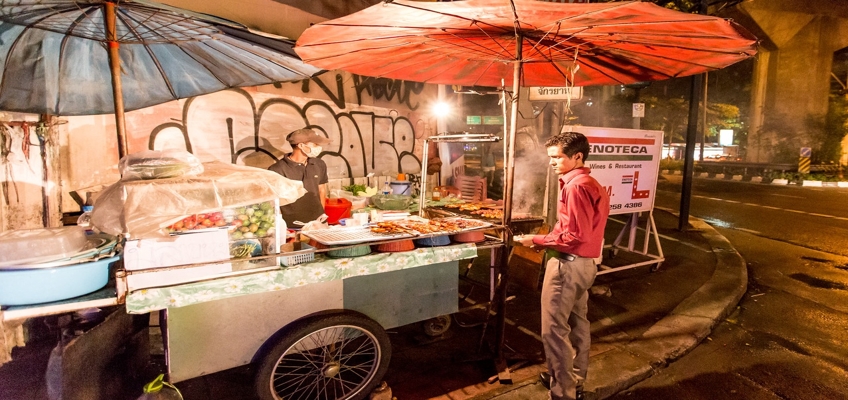
Cambodian cuisine is quite comparable to Chinese with the equivalent type of food stir-fried in a wok. By visiting the local restaurants, cafes, hotels or guesthouses on the Cambodia Holiday, it is possible to order a wide range of dishes, such as chicken or prawn with basil leaves or frog’s legs, pork or chicken stir-fried with garlic, spring onions or ginger.
Noodles or rice is likely to be stir-fried with chopped pieces of vegetables, crab, beef or pork. Other stir-fried dishes include sweet-and-sour dishes with pork or fish – though it is possible to order a vegetarian based version of the dish which can include ingredients like red or green tomatoes, onion or pineapple.
Curries and stews are everywhere to be seen in the cheap restaurants and market stalls. Most of the local curries are quite dry, mildly spicy and made with beef, while the stews make use of a fish or beef stock and include field melon or bitter melon.
Charcoal-grilled and smoky fish or chicken is a popular dish with the restaurants and roadside stalls. Chicken is mostly served with a sweet chilli sauce and salad garnish, and fish is complemented with fish sauce, garlic, chilli, and a dip of grated green mango.
Breakfast
A popular meal for breakfast in Cambodia is rice with fried pork or chicken with pickled vegetables, sliced cucumber and a bowl of clear soup. Other popular dishes in the mornings include a clear broth with beef, pork, or chicken pieces. For those travellers the country on the Cambodia travel packages, there are plenty of opportunities to enjoy a western breakfast at local restaurants, cafes, hotels, and guesthouses that caters for the tourists.

Noodles and rice
A serving of yellow egg noodles (mee) is prepared using wheat flour and goes with stir-fries and soups. A fresh serving of mee is widely available in the major towns, although it isn’t available across the entire country; many people have to contend with packets of instant noodles imported from neighbouring countries like Vietnam and Thailand. A common dish served on the roadside stalls is Loat chat which is a type of hollow noodle that is comparable to macaroni and fried using charcoal burners.
A dish of borbor is much like rice cooked up to create porridge. A serving of borbor is easy to buy at most low-cost restaurants, night markets and market stalls. It is practical as an evening dish or as a breakfast. To make borbor the more interesting dish it can include extra ingredients like fried vegetables, salted eggs, pickles, or dried fish. Other choices include cooking in a stock with small chunks of pork, fish or chicken, as well as bean sprouts just before serving.
Meat
Meat is quite expensive to include in the local dishes so it is mostly cut into small chunks and combined with a lot of vegetables. Pork is the most popular meat choice with plenty of pigs around even in the small villages. But with cows a favoured work animal, there is a lot less to eat. For instance, most of the best beef in the restaurants in large towns is imported.
Fish
One food type that is plentiful is fish which is regarded as the major protein source for those living in Cambodia. The Tonle Sap Lake gives a perfect destination for freshwater fish, while the coastline is perfect for the different sea fish species.
Fish is prepared in many different ways – in stews or soups, fried or grilled. A great dish to try on the Cambodia tours is amok, which is a type of mild fish curry combined with seasonings and coconut milk and wrapped before baking on banana leaves. A particular favourite with local Cambodians is dried fish. The largest freshwater fish is left to sun dry and later grilled over charcoal.

Vegetables
The market stalls in Cambodia are rich in the most common to the less familiar vegetables. A popular dish includes fried mixed vegetables with the choice of ingredients based on what is presently available. Crisp and refreshing green tomatoes are popular in many dishes, although the red tomatoes are reserved for the special recipes. A visit to the Chinese restaurants is a great choice for a varied range of vegetable dishes.
Gee is a generalized term for a wide range of herbs which are used to prepare or cook food. Plus, it can also be taken medicinally. Most of the herbs will be unidentified (such as young tree leaves, vines, types of water grass, etc.), except for coriander and mint.
Fruit
The markets in Cambodia are constantly filled with colourful fruit stalls with plenty of local fruits and imported grapes, pears and applies (imported fruit is a lot more expensive).
A popular cheap fruit is the banana which is found everywhere and is sold for about $0.25 per bunch. They are widely used for cooking, snacking and as offerings for the pagoda. Other less common fruits for the western traveller to Cambodia include durian (tooren), Longans (meeyan), guavas (troubike), soursops (tee-ab barang), and dragon fruit (pelai sroegar ne-yak).
Drinks
With Cambodian tap water not being particularly safe to drink on the Cambodia private tour, it is possible to find bottled water literally everywhere. Also, avoid ice in cold drinks, which has the risk of not being hygienic, except in the better quality restaurants.
Coffee and tea
Green tea is widely drunk in Cambodia and available to buy from market stalls and in coffee shops. Plus, it is often served free when eating at the better quality restaurants. Lemon tea is created by combining lemon juice and Chinese red-dust tea – this is very refreshing and great iced or hot. Black tea is a further choice and popular in the restaurants, guesthouses and hotels that cater to the foreign traveller.
Coffee is served in most of the restaurants, coffee shops and noodle shops up until the late afternoon, but less so in the evenings. Most of the coffee beans are imported from Vietnam or Laos, while there is also the locally grown coffee from Mondulkiri and Ratanakiri which is available in a few areas.





